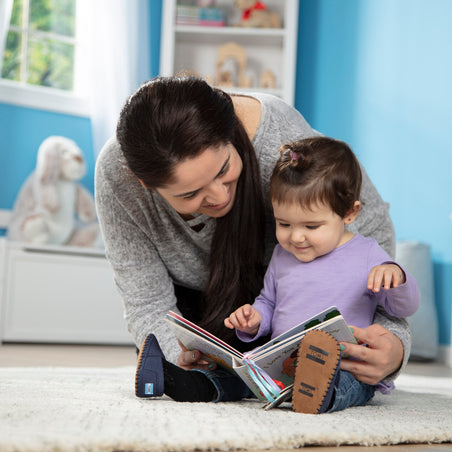[EDITOR'S NOTE: For more on learning through play, visit our Skills at Play page for more information about this initiative, which labels our website and toy packaging with skills-based callouts designed to help parents and caregivers easily identify which skills our various developmental and learning toys promote in babies and preschoolers.]
The moment your child utters his or her first word is a highly anticipated and magical event. For some children, learning to talk is fairly effortless. For others, it’s a struggle. For most children, we can do more to help—and we can do that through play.
Before children learn to talk, they learn to interact, to smile and laugh, to imitate, to gesture, to take turns, to play games like peek-a-boo, to make meaningful sounds and to understand familiar words. If words haven’t yet developed, then focus on all of these pre-verbal skills when playing with your little ones.
When using toys to engage your child, look for ones that hold their attention, pique their curiosity, encourage problem-solving and unleash their creativity—not all toys are created equal!
Tips for Finding the Best Toys to Improve Communication Skills
As a pediatric speech therapist, here’s what I know to be true about the best toys:
-
They generally require no batteries. This is important not only because the cost of batteries adds up quickly, but because quiet toys allow your child flexibility to make their own sounds as they play.
-
They allow children to be creative. Think about toys that can be played with in more than one way, can be used with other toys for new purposes, or can encourage a child to make a (purposeful) mess!
-
They inspire children to be active. Look for toys that encourage pushing, pulling, throwing, jumping, dancing, reaching, or even just making silly faces.
-
They encourage children to pretend. Consider toys that give children the opportunity to reenact the routines in which they participate or observe every day. Pretending to eat, sleep, get hurt, bathe, prepare food, clean, run errands and talk to others helps kids develop language, confidence, and more.
Toys That Build Communication Skills
I have found Melissa & Doug toys to be a favorite of speech-language pathologists who work with children. I have used various Melissa & Doug puzzles, pretend food sets, magnets, dress up clothes, vehicles and stacking toys in therapy sessions for many years. Here are three of my favorite toys that have helped me help little ones learn to play and learn to communicate:
1.Nesting & Sorting Garages & Cars
The best part of stacking is often knocking it all down! If your little one is not yet able to stack, then let them be involved by counting down the “kaboom” or “crash” or completing the “Ready, set . . . GO!” Stack it up again by saying “up,” “on top,” and naming the colors.
The Nesting & Sorting Garages & Cars is perfect for practicing directional language while zooming the colorful wooden cars, building with the seven graduated garages, and matching the coordinated colors. Using words like “in,” “out”, “on”, and “under”, children develop an understanding of spatial relationships and the words to express them. There are lots of ways to play and learn with this versatile set! Arrange the garages to make a colorful town, or stack them to make a tower tall with language learning opportunities as you name the colors and numbers with your child! My favorite part of this toy is playing hide-and-seek with other items under the garages. Say “Your turn” or “My turn” and alternate lifting the garages with your child to discover what’s underneath. Try your favorite Melissa & Doug puzzle pieces! This adds an element of surprise to basic puzzle play. This toy opens up endless opportunities for stacking, counting, hide-and-seek, mix-and-match, imaginative play and of course, language!
2. Pound & Roll Tower
The Pound & Roll Tower features a sturdy wooden hammer and four brightly colored balls to pound, match, and talk about. Name the color, then pound the ball, saying “bye, bye” and “whee” or “roll, roll, roll” all the way to the bottom. As the ball rolls out of the bottom you can celebrate with your child saying “ta-da” or “yay.” When using this toy, you can also stand it on top of a bin or basket so that the balls drop down making a “clunk” or a “boom!” Retrieve the ball and bring it “up, up, up” to the top and put it “in” the four “circle” openings, even counting “one, two, three, four!” For extra sensory and speech fun, use the tune of “Wheels on the Bus” and sing The red ball in tower goes down, down, down . . . down, down, down . . . down, down, down . . . The blue ball in the tower goes down, down, down . . . all day long!
3. Farm Magnets
Get your animal sounds ready! Animal sounds and other meaningful sounds such as “uh-oh,” “brrrr,” “aha,” and “hmmm” are super important to speech development. With Farm Magnets, you get to practice “neigh,” “moo,” “oink,” and tractor sounds “chug chug chug.” If your refrigerator holds magnets then these toys can give your little one a kitchen task while you are busy with meal prep or cleaning.
Get out that “mystery box” from the stacking toy and put the magnets inside. Your child can take each piece out and stick it to the fridge. Then, take each one off the fridge, put them back in the box and say “bye bye” to each animal. However, some refrigerators are not made for magnets. In that case, cookie sheets are perfect! Use a small cookie sheet in the car with your toddler or preschooler for magnet play on the go.
Go beyond animal sounds and use the magnets to set up scenes or trace each animal then use the outlines on a piece of paper as a puzzle. Pretend to feed each animal with your Melissa & Doug play food or put each animal to sleep, “Shh, night night,” by turning them over. Hide the animals around a darker room and then use a flashlight to find them, “Cow, where are you?” Drop the magnets into a dry sensory bin of uncooked pasta, rice, leaves, feathers, etc. Then announce each one by name or sound as you dig them out and stick them to that cookie sheet. To practice concepts like above, below, top, middle, and bottom, draw lines on a piece of paper and tape the paper to a magnetic surface. Then organize the magnets by saying, “Put the cow above the tractor” or “The horse goes on the top line.”
4. Service Station Parking Garage
Your little car lover will get good use out of this Service Station Parking Garage! The cars go “up” and “down” in the elevator, park and “stop” in the numbered spots, slide “whee” or “go” fast down the ramp, fill up with gas “guhguhguh” and get clean in the car wash “scrub scrub” and “ssshhhh” for water spraying sounds. Finally, the cars can go into the garage when broken (“uh-oh”) to get fixed or to sleep for the night “Shh, night, night car.” Little ones may need some help moving the elevator or using the car wash so that’s a wonderful opportunity for you to teach them how to the use the word “help.”
Tips for Success With Speech and Language Skills
Remember when playing with your child to use sounds and words which are at, or just above, your child’s expressive ability if you want them to try to imitate what you are saying. If your child hasn’t yet said a true word, then you can use single words or meaningful sounds rather than long sentences. If your child is using some words, then you can use two- or three-word phrases in play. Reduce the questions you ask and just give them the words they might want to say. Follow your child’s lead in play, and who knows where their imagination will lead you!
Follow the links below for more great toy content from Melissa & Doug:
Shop All Melissa & Doug Learning Toys
Explore Melissa & Doug’s Living Playfully Blog
Use the Melissa & Doug Gift Finder
Explore Melissa & Doug Skills at Play
Shop Melissa & Doug Toys by Age















